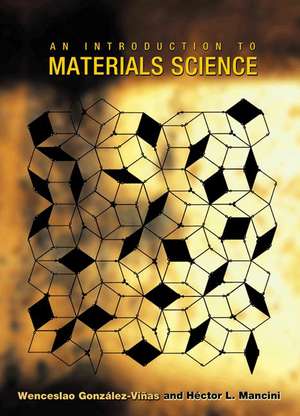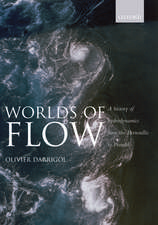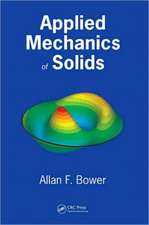An Introduction to Materials Science
Autor Wenceslao González–viñas, Hector L. Mancini, Héctor L. Mancinien Limba Engleză Hardback – 24 iun 2004
Materials science has undergone a revolutionary transformation in the past two decades. It is an interdisciplinary field that has grown out of chemistry, physics, biology, and engineering departments. In this book, Gonzlez-Vias and Mancini provide an introduction to the field, one that emphasizes a qualitative understanding of the subject, rather than an intensely mathematical one.
The book covers the topics usually treated in a first course on materials science, such as crystalline solids and defects. It describes the electrical, mechanical, and thermal properties of matter; the unique properties of dielectric and magnetic materials; the phenomenon of superconductivity; polymers; and optical and amorphous materials. More modern subjects, such as fullerenes, liquid crystals, and surface phenomena are also covered, and problems are included at the end of each chapter.
"An Introduction to Materials Science" is addressed to both undergraduate students with basic skills in chemistry and physics, and those who simply want to know more about the topics on which the book focuses.
Preț: 650.17 lei
Preț vechi: 802.68 lei
-19% Nou
Puncte Express: 975
Preț estimativ în valută:
124.44€ • 129.41$ • 104.13£
124.44€ • 129.41$ • 104.13£
Carte tipărită la comandă
Livrare economică 15-29 martie
Preluare comenzi: 021 569.72.76
Specificații
ISBN-13: 9780691070971
ISBN-10: 0691070970
Pagini: 200
Ilustrații: 138 line Illus. 10 tables.
Dimensiuni: 185 x 262 x 18 mm
Greutate: 0.62 kg
Editura: Princeton University Press
Locul publicării:Princeton, United States
ISBN-10: 0691070970
Pagini: 200
Ilustrații: 138 line Illus. 10 tables.
Dimensiuni: 185 x 262 x 18 mm
Greutate: 0.62 kg
Editura: Princeton University Press
Locul publicării:Princeton, United States
Cuprins
List of Figures xi
List of Tables xv
Preface xvii
Chapter 1. What Is a Material? 1
1.1 Classifications 3
1.2 Fundamental Properties of Different Kinds of Materials 4
Chapter 2. Crystalline Solids 6
2.1 Order, Translational Invariance, and Anisotropy 9
2.2 Bravais Lattice, Wigner-Seitz Cell, Reciprocal Lattice, and First Brillouin Zone 10
2.3 Crystalline Structures: Types of Crystals and Their Properties 13
2.4 Schrödinger Equation, Periodic Potentials and Bloch's Theorem, and Energy Bands 17
2.5 Conductors, Insulators, and Semiconductors 20
2.6 Characterization of Crystal Structures 26
Problems 28
Chapter 3. Imperfections 31
3.1 Defects: Types of Defects and Vibrations 31
3.2 Point Defects: Frenkel and Schottky Defects 31
3.3 Dislocations and Disclinations 35
3.4 Planar Defects and Grain Size 37
3.5 Defect Detection 38
3.6 Amorphous Materials 38
Problems 39
Chapter 4. Electrical Properties 40
4.1 Electrical Conductivity and Temperature 40
4.2 Thermoelectric and Galvanomagnetic Effects 41
4.3 Semiconductor Electronic Devices 44
Problems 49
Chapter 5. Mechanical and Thermal Properties 50
5.1 Mechanical Properties 50
5.2 Phonons 52
5.3 Thermal Properties 53
Problems 55
Chapter 6. Magnetic Materials and Dielectrics 56
6.1 Diamagnetism and Paramagnetism 57
6.2 Ferromagnetism, Ferrimagnetism, and Antiferromagnetism 60
6.3 Magnetic Resonances 64
6.4 Applications 64
6.5 Dielectrics 65
Problems 68
Chapter 7. Superconductivity 70
7.1 Introduction and Applications 70
7.2 Type I and Type II Superconductors 72
7.3 Josephson Effect 76
Problems 80
Chapter 8. Optical Materials 81
8.1 The Interaction of Radiation with Matter 81
8.2 Optical Parameters 83
8.3 Propagation of Light in Solids 85
8.4 Absorption and Emission of Radiation in Solids 88
8.5 Lasers 94
8.6 Effects of the Crystalline Structure on the Refractive Index 99
Problems 100
Chapter 9. Noncrystalline Materials 102
9.1 Quasicrystals 103
9.2 Glasses and Glassy Materials 113
9.3 Metallic Glasses 117
9.4 Amorphous Ferromagnets 117
9.5 Amorphous Semiconductors 118
9.6 Low-Energy Excitations in Amorphous Solids 119
Problems 119
Chapter 10. Polymeric Materials 121
10.1 Molecular Structure 123
10.2 Macromolecular Architecture 130
10.3 Crystalline, Semicrystalline, and Amorphous Polymeric Materials 134
10.4 Distribution of Molecular Weights and Sizes 137
10.5 Polymerization Procedures 141
10.6 Properties of Polymeric Materials 144
10.7 Design Polymers 153
Problems 156
Chapter 11. Surface Science 158
11.1 Electronic Structure of Surfaces 158
11.2 Nanocrystalline Surface Formation 161
Problems 162
Chapter 12. New Materials 164
12.1 Fullerenes 164
12.2 Liquid Crystals 165
12.3 Biocompatible Materials 167
Appendix A. Physical Constants 171
Bibliography 173
Index 175
List of Tables xv
Preface xvii
Chapter 1. What Is a Material? 1
1.1 Classifications 3
1.2 Fundamental Properties of Different Kinds of Materials 4
Chapter 2. Crystalline Solids 6
2.1 Order, Translational Invariance, and Anisotropy 9
2.2 Bravais Lattice, Wigner-Seitz Cell, Reciprocal Lattice, and First Brillouin Zone 10
2.3 Crystalline Structures: Types of Crystals and Their Properties 13
2.4 Schrödinger Equation, Periodic Potentials and Bloch's Theorem, and Energy Bands 17
2.5 Conductors, Insulators, and Semiconductors 20
2.6 Characterization of Crystal Structures 26
Problems 28
Chapter 3. Imperfections 31
3.1 Defects: Types of Defects and Vibrations 31
3.2 Point Defects: Frenkel and Schottky Defects 31
3.3 Dislocations and Disclinations 35
3.4 Planar Defects and Grain Size 37
3.5 Defect Detection 38
3.6 Amorphous Materials 38
Problems 39
Chapter 4. Electrical Properties 40
4.1 Electrical Conductivity and Temperature 40
4.2 Thermoelectric and Galvanomagnetic Effects 41
4.3 Semiconductor Electronic Devices 44
Problems 49
Chapter 5. Mechanical and Thermal Properties 50
5.1 Mechanical Properties 50
5.2 Phonons 52
5.3 Thermal Properties 53
Problems 55
Chapter 6. Magnetic Materials and Dielectrics 56
6.1 Diamagnetism and Paramagnetism 57
6.2 Ferromagnetism, Ferrimagnetism, and Antiferromagnetism 60
6.3 Magnetic Resonances 64
6.4 Applications 64
6.5 Dielectrics 65
Problems 68
Chapter 7. Superconductivity 70
7.1 Introduction and Applications 70
7.2 Type I and Type II Superconductors 72
7.3 Josephson Effect 76
Problems 80
Chapter 8. Optical Materials 81
8.1 The Interaction of Radiation with Matter 81
8.2 Optical Parameters 83
8.3 Propagation of Light in Solids 85
8.4 Absorption and Emission of Radiation in Solids 88
8.5 Lasers 94
8.6 Effects of the Crystalline Structure on the Refractive Index 99
Problems 100
Chapter 9. Noncrystalline Materials 102
9.1 Quasicrystals 103
9.2 Glasses and Glassy Materials 113
9.3 Metallic Glasses 117
9.4 Amorphous Ferromagnets 117
9.5 Amorphous Semiconductors 118
9.6 Low-Energy Excitations in Amorphous Solids 119
Problems 119
Chapter 10. Polymeric Materials 121
10.1 Molecular Structure 123
10.2 Macromolecular Architecture 130
10.3 Crystalline, Semicrystalline, and Amorphous Polymeric Materials 134
10.4 Distribution of Molecular Weights and Sizes 137
10.5 Polymerization Procedures 141
10.6 Properties of Polymeric Materials 144
10.7 Design Polymers 153
Problems 156
Chapter 11. Surface Science 158
11.1 Electronic Structure of Surfaces 158
11.2 Nanocrystalline Surface Formation 161
Problems 162
Chapter 12. New Materials 164
12.1 Fullerenes 164
12.2 Liquid Crystals 165
12.3 Biocompatible Materials 167
Appendix A. Physical Constants 171
Bibliography 173
Index 175
Notă biografică
Wenceslao González-Viñas is Professor of Materials Science at the University of Navarre (Spain). Héctor L. Mancini is Professor and Director of the Institute of Physics and of the Department of Physics and Applied Mathematics at the University of Navarre.
Descriere
Aimed at the undergraduate students with basic skills in chemistry and physics, this book provides an introduction to the field of material science. It covers the topics, such as crystalline solids and defects, and describes the electrical, mechanical, and thermal properties of matter; the phenomenon of superconductivity; polymers; and more.













